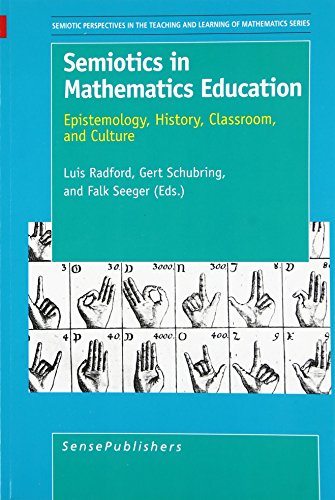Semiotics in Mathematics Education: Epistemology, History, Classroom, and Culture (Semiotic Perspectives in the Teaching and Learning of Mathematics, 1) - Softcover

"synopsis" may belong to another edition of this title.
This volume discusses semiotics in mathematics education as an activity with a formal sign system, in which each sign represents something else. Theories presented by Saussure, Peirce, Vygotsky and other writers on semiotics are summarized in their relevance to the teaching and learning of mathematics. The significance of signs for mathematics education lies in their ubiquitous use in every branch of mathematics. Such use involves seeing the general in the particular, a process that is not always clear to learners. Therefore, in several traditional frameworks, semiotics has the potential to serve as a powerful conceptual lens in investigating diverse topics in mathematics education research. Topics that are implicated include (but are not limited to): the birth of signs; embodiment, gestures and artifacts; segmentation and communicative fields; cultural mediation; social semiotics; linguistic theories; chains of signification; semiotic bundles; relationships among various sign systems; intersubjectivity; diagrammatic and inferential reasoning; and semiotics as the focus of innovative learning and teaching materials.
Gert Schubring is department head at the Institut für Didaktik der Mathematik at Bielefeld University, Germany. His research interests focus on the history of mathematics and the sciences in the eighteenth and nineteenth centuries and on their systemic interrelation with socio-cultural systems.
Falk Seeger is retired from a position of Senior Lecturer at the Institut für Didaktik der Mathematik at Bielefeld University, Germany. His research interests include the analysis of mathematical learning from a cultural-historical perspective. In his current work, he puts a focus on the semiotic roots of intentionality in human development, drawing heavily on Vygotsky’s work and on Peirce’s ideas.
"About this title" may belong to another edition of this title.
- PublisherBrill Academic Pub
- Publication date2008
- ISBN 10 9087905955
- ISBN 13 9789087905958
- BindingPaperback
- Number of pages273
- EditorRadford Luis, Schubring Gert, Seeger Falk
Buy New
Learn more about this copy
Shipping:
US$ 12.71
From United Kingdom to U.S.A.
Top Search Results from the AbeBooks Marketplace
Semiotics in Mathematics Education: Epistemology, History, Classroom, and Culture (Semiotic Perspectives in the Teaching and Learning of Mathematics)
Book Description Paperback. Condition: Brand New. 273 pages. 9.00x6.00x0.75 inches. In Stock. This item is printed on demand. Seller Inventory # __9087905955

